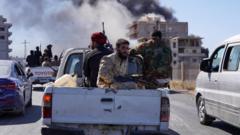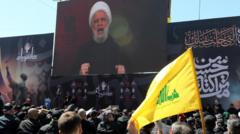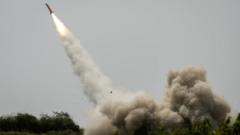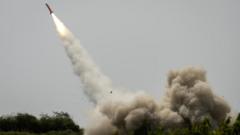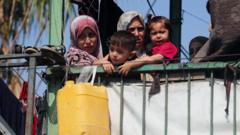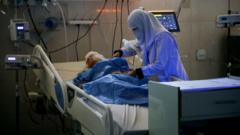Following a recent 7.7 magnitude earthquake, Myanmar's military ruler has announced plans to fully redraw and reinforce the capital city Nay Pyi Taw, highlighting the need for earthquake-resistant structures and soil testing.
**Nay Pyi Taw's Future: Major Redesign Following Earthquake Destruction**
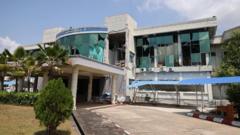
**Nay Pyi Taw's Future: Major Redesign Following Earthquake Destruction**
Myanmar's military government plans a comprehensive redesign of Nay Pyi Taw after significant earthquake destruction revealed serious infrastructure vulnerabilities.
The city's extensive infrastructure has suffered major damage, necessitating relocation of government offices and urgent reconstruction efforts amid ongoing civil conflict.
Nay Pyi Taw, Myanmar's capital since 2005, will undergo a major redesign following a devastating earthquake last month that left the city in ruins. Senior General Min Aung Hlaing stated during a government meeting that many buildings collapsed due to being constructed on unstable soft soil. He emphasized that future constructions will need to be robust enough to withstand future seismic events and announced that soil tests would guide the rebuilding process.
Evidence from the BBC indicates that around 70% of government structures in Nay Pyi Taw were affected by the quake on March 28, which registered a magnitude of 7.7 and was felt as far as Thailand and south-west China. The catastrophe resulted in over 3,500 fatalities and more than 5,000 injuries across Myanmar.
Nay Pyi Taw is a vast city, stretching over four times the area of London but housing significantly fewer residents. Its existence as a capital is relatively new, having been established from scratch by military leaders in 2005—though the reasons behind relocating the capital from Yangon remain ambiguous. The layout of Nay Pyi Taw features palatial government buildings and wide roadways that are often devoid of traffic, symbolizing a planned capital's grandeur, but its emptiness also highlights its underpopulation.
Since the military coup in 2021, Myanmar has plunged into chaotic civil warfare. Recent tensions have exacerbated the situation; however, a temporary ceasefire was declared to facilitate humanitarian relief on April 2, following announcements from various rebel factions. Despite the ceasefire, reports have surfaced indicating continued military attacks on areas held by insurgent groups.
Damage caused by the earthquake has necessitated the relocation of multiple government departments, including the Ministry of Foreign Affairs and the Ministry of Tourism, moving their operations back to the former capital, Yangon, located approximately 366 kilometers (228 miles) away. In preparation for reconstruction, important documents and equipment are being salvaged and moved.
In light of these developments, staff at the National Museum in Nay Pyi Taw are focused on preserving valuable cultural assets—working tirelessly to protect thousands of manuscripts, books, and essential pieces of literature and technology.
Nay Pyi Taw, Myanmar's capital since 2005, will undergo a major redesign following a devastating earthquake last month that left the city in ruins. Senior General Min Aung Hlaing stated during a government meeting that many buildings collapsed due to being constructed on unstable soft soil. He emphasized that future constructions will need to be robust enough to withstand future seismic events and announced that soil tests would guide the rebuilding process.
Evidence from the BBC indicates that around 70% of government structures in Nay Pyi Taw were affected by the quake on March 28, which registered a magnitude of 7.7 and was felt as far as Thailand and south-west China. The catastrophe resulted in over 3,500 fatalities and more than 5,000 injuries across Myanmar.
Nay Pyi Taw is a vast city, stretching over four times the area of London but housing significantly fewer residents. Its existence as a capital is relatively new, having been established from scratch by military leaders in 2005—though the reasons behind relocating the capital from Yangon remain ambiguous. The layout of Nay Pyi Taw features palatial government buildings and wide roadways that are often devoid of traffic, symbolizing a planned capital's grandeur, but its emptiness also highlights its underpopulation.
Since the military coup in 2021, Myanmar has plunged into chaotic civil warfare. Recent tensions have exacerbated the situation; however, a temporary ceasefire was declared to facilitate humanitarian relief on April 2, following announcements from various rebel factions. Despite the ceasefire, reports have surfaced indicating continued military attacks on areas held by insurgent groups.
Damage caused by the earthquake has necessitated the relocation of multiple government departments, including the Ministry of Foreign Affairs and the Ministry of Tourism, moving their operations back to the former capital, Yangon, located approximately 366 kilometers (228 miles) away. In preparation for reconstruction, important documents and equipment are being salvaged and moved.
In light of these developments, staff at the National Museum in Nay Pyi Taw are focused on preserving valuable cultural assets—working tirelessly to protect thousands of manuscripts, books, and essential pieces of literature and technology.

